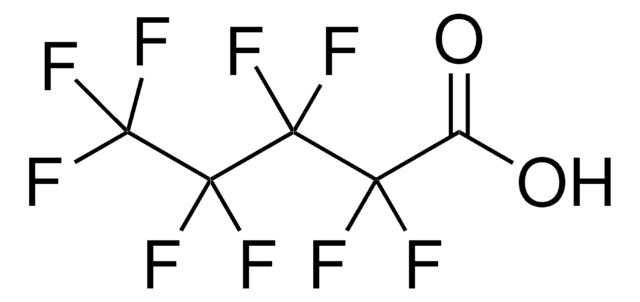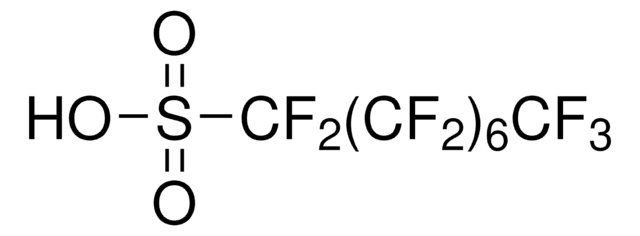Key Documents
43996
Perfluoroheptanoic acid
analytical standard
Synonim(y):
Tridecafluoroheptanoic acid, PFAS, Perfluoroheptanoic acid
About This Item
Polecane produkty
klasa czystości
analytical standard
agency
suitable for ASTM® 7968
suitable for ASTM® 7979
suitable for DIN 38407-42
suitable for EPA 1633
suitable for EPA 533
suitable for EPA 537.1
suitable for EPA 8327
suitable for EPA ACB B21-02
suitable for EPA ACB B23-05b
suitable for EPA OTM-45
suitable for ISO 21675 2019
zgodność regionalna
suitable for FDA C-010.02
Próba
≥98.0% (GC)
okres trwałości
limited shelf life, expiry date on the label
współczynnik refrakcji
n20/D 1.306 (lit.)
tw
175 °C/742 mmHg (lit.)
gęstość
1.792 g/mL at 25 °C (lit.)
temp. przechowywania
2-8°C
ciąg SMILES
OC(=O)C(F)(F)C(F)(F)C(F)(F)C(F)(F)C(F)(F)C(F)(F)F
InChI
1S/C7HF13O2/c8-2(9,1(21)22)3(10,11)4(12,13)5(14,15)6(16,17)7(18,19)20/h(H,21,22)
Klucz InChI
ZWBAMYVPMDSJGQ-UHFFFAOYSA-N
Szukasz podobnych produktów? Odwiedź Przewodnik dotyczący porównywania produktów
Powiązane kategorie
Opis ogólny
PFCAs have been used widely as wetting agents, lubricants, corrosion inhibitors, foam fire extinguishants, and in the manufacture of fluoropolymers due to their highly surface-active nature, chemical and thermal stabilities. Because of their widespread use and their persistence in the environment, many PFAS are found in the blood of people and animals all over the world and are present at low levels in a variety of food products and the environment. Animal testing has revealed a number of toxic effects caused by these compounds, particularly with regard to tumor growth and reproductive toxicity.
Perfluoroheptanoic acid is included in a variety of norms to be tested in soil, water, wastewater, sludge, food, and textiles/leather.
- ASTMD7968-17a: Determination of Polyfluorinated Compounds in Soil
- ASTMD7979-20: Determination of Per- and Polyfluoroalkyl Substances in Water, Sludge, Influent, Effluent, and Wastewater
- EPA533, EPA 537.1: Determination of per and polyfluoroalkyl substances in drinking water
- FDAC-010.01: Determination of 16 Perfluoroalkyl and Polyfluoroalkyl Substances in Food (matrices: lettuce, milk, fish)
- ISO21675: Determination of perfluoroalkyl and polyfluoroalkyl substances in water(non-filtrated e.g. drinking water, natural water, wastewater containing less than 2 g/L solid particulate material
- DINEN 23702: Determination of non-volatile extractable perfluorinated and polyfluorinated substances in leather and coated leather
- DIN38407-42: Determination of selected polyfluorinated compounds in water
- DIN 38414-14: Determination of selected polyfluorinated compounds in sludge, compost, and soil
Zastosowanie
- Decomposition of perfluorooctanoic acid (PFOA) under sonication-assisted photocatalysis using TiO2
- To study the toxicokinetics between perfluoroheptanoic acid (PFHA), perfluorooctanoic acid (PFOA), perfluorononanoic acid (PFNA), and perfluorodecanoic acid (PFDA) in male and female rats
- To assess the acute toxicity of perfluorohexanoic acid, perfluoroheptanoic acid, perfluorooctanoic acid, perfluorononanoic acid, and perfluorodecanoic acid using eukaryotic cell lines, bacteria, and enzymatic assays
- Determination of 15 selected synthetic cannabinoids and their metabolites by micellar electrokinetic chromatography-mass spectrometry using perfluoroheptanoic acid-based micellar phase
- To study the signal suppression in liquid chromatography-electrospray ionization mass spectrometry using volatile ion-pairing reagents like trifluoroacetic acid, heptafluorobutanoic acid, and perfluoroheptanoic acid
Informacje prawne
Hasło ostrzegawcze
Danger
Zwroty wskazujące rodzaj zagrożenia
Zwroty wskazujące środki ostrożności
Klasyfikacja zagrożeń
Repr. 1B - STOT RE 1
Organy docelowe
Liver
Kod klasy składowania
6.1C - Combustible acute toxic Cat.3 / toxic compounds or compounds which causing chronic effects
Klasa zagrożenia wodnego (WGK)
WGK 3
Temperatura zapłonu (°F)
Not applicable
Temperatura zapłonu (°C)
Not applicable
Wybierz jedną z najnowszych wersji:
Certyfikaty analizy (CoA)
Nie widzisz odpowiedniej wersji?
Jeśli potrzebujesz konkretnej wersji, możesz wyszukać konkretny certyfikat według numeru partii lub serii.
Masz już ten produkt?
Dokumenty związane z niedawno zakupionymi produktami zostały zamieszczone w Bibliotece dokumentów.
Nasz zespół naukowców ma doświadczenie we wszystkich obszarach badań, w tym w naukach przyrodniczych, materiałoznawstwie, syntezie chemicznej, chromatografii, analityce i wielu innych dziedzinach.
Skontaktuj się z zespołem ds. pomocy technicznej






